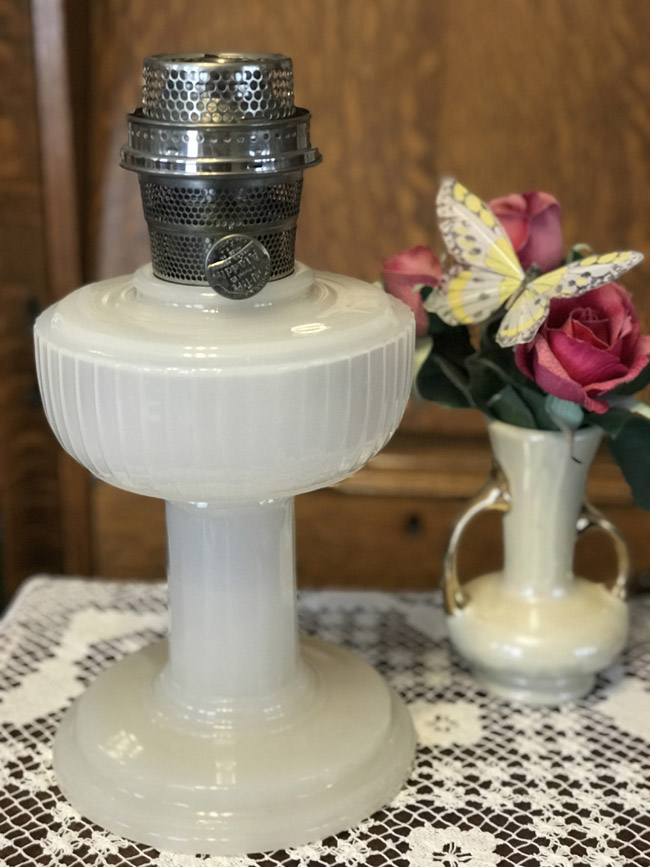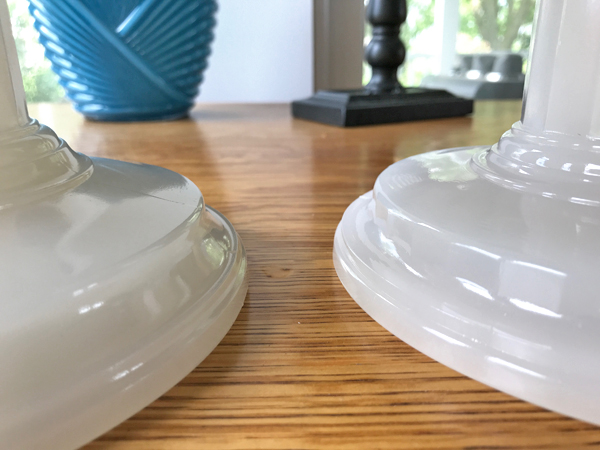

 |
What many Aladdin collectors are unaware of when it comes to the Solitaire lamp is the fact that there are actually two variations of it. One, like the example on the right, has a series of flat panels molded into the upper rim of the base. The other example, like the lamp on the left, lacks the flat panels and is completely smooth. Considering that the actual number of Solitaire lamps to be produced is only around on thousand you have to wonder just how many of each design were manufactured. The flat panel design is thought by some Aladdin collectors to be the first model produced and that the panels themselves caused a problem in manufacturing the lamp. They believe that the panels were not easily shaped as the glass entered the mold, or possibly that they produced a problem when trying to remove the lamp from the mold. For whatever reason the theory is that the mold was modified to do away with the flat panels due to the problem they caused with production of the Solitaire lamp. For what it's worth, my own belief is that there were actually two different molds used to produce the Solitaire lamps. I believe this because the Aladdin Mantle Lamp Co. did so with several of their other lamps as well. The Queen lamps can be found with two different oil fonts. One has a scalloped edge at the top of the font while the other does not. Alacite and cobalt blue tall Lincoln drape lamps were produced with a plain foot base, as well as a scallop foot base. Short Lincoln drape lamps normally have a rounded edge to the base, but can also be found with a larger base with a stepped design commonly referred to as the "Solitaire foot" or "broad foot" design. The porcelain Victoria lamp no only has two different flower decals, but two different shapes to go with the decals that indicates the use of a second mold. These variances in lamps of the same design, lead me to believe that the two variations of the Solitaire lamp did not arise from the modification of the original mold, but rather was the result of two different molds being used in it's production. Even at that the lamp still is shrouded in some mystery. How many of each style were manufactured? Nobody knows, since no written record about there differences has ever been found. Neither has a record of exactly how many Solitaire lamps were produced, although it is thought to be one thousand or less. There is also no sales brochure, or literature, that shows the Solitaire lamp. For whatever reason there is no substantiated evidence to prove that the lamp was ever sold to the public yet the lamp exists in numbers to suggest it was marketed at least to a limited degree. It is indeed a lamp of mystery.
|
 |
In this photo the smooth foot Solitaire is on the left and the Solitaire with the paneled foot is on the right. You can see the light reflecting from the flat panels. The panels don't stand out dramatically and from even a short distance away it is hard to identify them. They can however be readily felt if you run your finger around the edge of the step. |